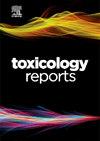Per- and polyfluorinated substances (PFAS) promote osteoclastogenesis and bone loss through PPARα activation
Q1 Environmental Science
引用次数: 0
Abstract
Per- and polyfluoroalkyl substances (PFAS) are emerging as significant environmental contaminants affecting bone health, with studies linking their exposure to decreased bone mineral density (BMD), enhanced osteoclastogenesis, and disruptions in the bone marrow microenvironment. While current research highlights the effects on bone and BMD, there is a critical gap in understanding the mechanisms behind these effects. Studies presented here investigate the effects of legacy and alternative PFAS, particularly hexafluoropropylene oxide dimer acid (GenX) and perfluorohexane sulfonic acid (PFHxS), on bone health using in vitro and in vivo models. An environmentally relevant mixture of five PFAS was found to promote osteoclastic differentiation of murine bone marrow macrophages (BMMs) in vitro. Among the five components of the Mixture, the emerging compound, GenX, had the highest propensity to induce osteoclastogenesis. Utilizing pharmacological and genetic approaches, we identified peroxisome proliferator-activated receptor alpha (PPARα) as a potential mediator of PFAS-driven osteoclastogenesis. Furthermore, our in vivo mouse experiments demonstrated a decrease in trabecular and cortical bone thickness as well as altered bone mineral composition in male FVB/N mice exposed to either GenX or PFHxS (2 mg/L) for 12 weeks. Altogether, our results reveal potentially negative effects of PFAS exposure on BMD, bone mineral composition, and overall bone health and underscore the need for further research assessing the health risks associated with exposure to alternative PFAS.
全氟和多氟物质(PFAS)通过激活PPARα促进破骨细胞生成和骨质流失
全氟烷基和多氟烷基物质(PFAS)正在成为影响骨骼健康的重要环境污染物,研究表明,接触它们会导致骨密度下降、破骨细胞生成增强和骨髓微环境破坏。虽然目前的研究强调了对骨骼和骨密度的影响,但在理解这些影响背后的机制方面存在关键差距。本文提出的研究通过体外和体内模型探讨了遗留和替代PFAS,特别是六氟环氧丙烷二聚酸(GenX)和全氟己烷磺酸(PFHxS)对骨骼健康的影响。研究发现,五种PFAS的环境相关混合物可促进体外小鼠骨髓巨噬细胞(BMMs)的破骨细胞分化。在混合物的五种成分中,新兴化合物GenX具有最高的诱导破骨细胞发生的倾向。利用药理学和遗传学方法,我们发现过氧化物酶体增殖物激活受体α (PPARα)是pfas驱动的破骨细胞发生的潜在介质。此外,我们的小鼠体内实验表明,雄性FVB/N小鼠暴露于GenX或PFHxS(2 mg/L) 12周后,骨小梁和皮质骨厚度减少,骨矿物质组成改变。总之,我们的研究结果揭示了PFAS暴露对骨密度、骨矿物质组成和整体骨骼健康的潜在负面影响,并强调了进一步研究评估与暴露于替代PFAS相关的健康风险的必要性。
本文章由计算机程序翻译,如有差异,请以英文原文为准。
求助全文
约1分钟内获得全文
求助全文
来源期刊

Toxicology Reports
Environmental Science-Health, Toxicology and Mutagenesis
CiteScore
7.60
自引率
0.00%
发文量
228
审稿时长
11 weeks
 求助内容:
求助内容: 应助结果提醒方式:
应助结果提醒方式:


